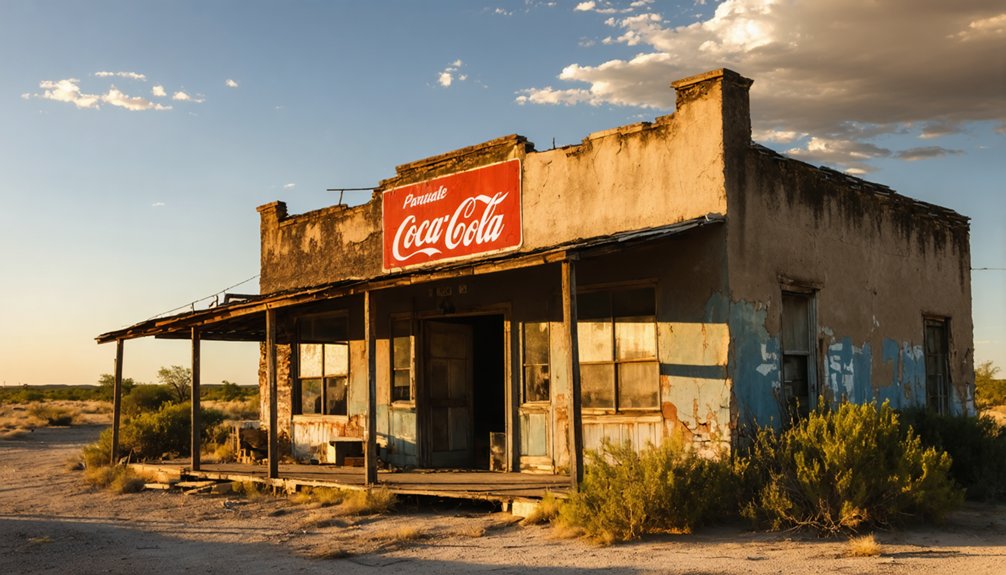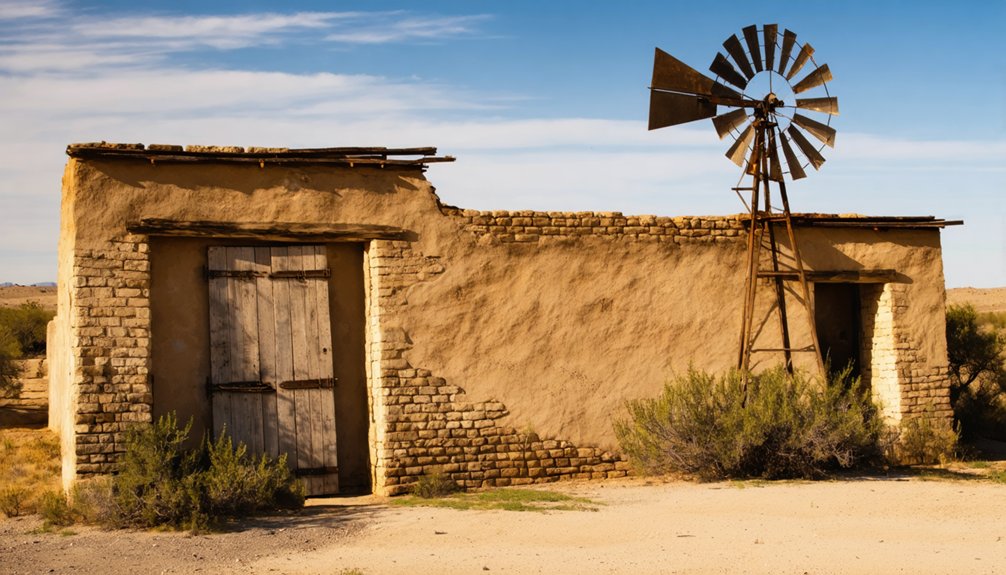In Val Verde County’s remote desert region, you’ll find Pandale – a historic ghost town situated at a vital Pecos River crossing point. This former ranching settlement peaked in the 1920s-30s with essential services like a general store, schoolhouse, and the Mills family’s two-story stone house. Today, only twenty permanent residents remain among the preserved structures, while river adventurers use it as a launching point. The town’s rich history spans thousands of years of human activity.
Key Takeaways
- Pandale, Texas, a remote desert settlement in Val Verde County, maintains only twenty permanent residents since the late 1930s.
- The community’s decline began with school district merger in 1969, post office closure in 1977, and final business shutdown in 1973.
- Historical structures remain from its 1928 founding, including a general store, schoolhouse, and the Mills family’s two-story stone house.
- Located at a strategic Pecos River crossing, Pandale transformed from ranching settlement to launch point for river adventures.
- The town’s isolation, marked by 13 miles of unpaved road, preserves its ghost town character while attracting history enthusiasts.
The Valley That Time Forgot
Nestled in a remote desert region of Val Verde County, Texas, Pandale embodies the essence of a forgotten valley. You’ll find this ghost town‘s distinctive character in its pan-shaped dale, which gave the settlement its name and defines its unique geographic features.
The last 13 miles of unpaved road amplify the isolation you’ll experience as you venture through rural West Texas. The rugged, arid landscape stretches for miles, with the Pecos River serving as the only significant natural landmark. Today, just twenty permanent residents call this secluded area home. Once a vibrant community, the town boasted churches and businesses that served as the heartbeat of local life.
You’re more than 40 miles from the nearest sizable town of Ozona, truly placing you in one of Texas’s most secluded locations. This geographic isolation has preserved Pandale’s history as an untouched time capsule, where the stark beauty of the desert meets the remnants of frontier life.
Early Settlement and River Crossing Days
Before Pandale became a ghost town, its strategic location along the Pecos River shaped thousands of years of human history.
Pandale’s prime position by the Pecos River made it a crucial crossroads long before its decline into abandonment.
You’ll find evidence of early inhabitants stretching back 10,000 years, with the river crossing serving as an essential lifeline for movement between central and far West Texas. The area’s significance in river trade drew various indigenous groups, including Lipan Apaches, Coahuiltecans, and later, Comanches. Like many other settlers who came to Texas seeking land and opportunity, early residents were drawn to the area’s natural resources.
- Archaeological discoveries reveal extensive use of rock shelters and caves
- Early inhabitants left behind dart points, painted pebbles, and clay figurines
- Food remains show reliance on local plants, prepared in earth ovens
- The crossing remained critical for travelers even after European contact
While Spanish explorers like Cabeza de Vaca passed through in 1535, the area stayed relatively untouched by colonial influence until the ranching era. The region’s limestone plateau landscape created unique geological features that early inhabitants used for shelter and defense.
Ranching Glory Years
You’ll find the 1920s and early 1930s marked the peak of Pandale’s ranching era, with large cattle drives connecting the area’s commerce to major regional markets.
Your understanding of this period would note how ranch families, particularly those owning the Pandale Ranch and Mills Pecos River Ranch, accumulated substantial land holdings through strategic acquisitions.
Among these notable ranches, the historic Pandale Ranch began with over 40,000 acres when it was first homesteaded in 1879.
The prosperity from these ranching operations allowed families to build impressive limestone structures and establish themselves as influential figures in the regional cattle industry.
Like other ranchers in Texas, they faced the devastating effects of the Big Die-Up, when the harsh winter of 1886-1887 decimated cattle populations across the region.
Cattle Drives and Commerce
During the ranching glory years of the 1860s through early 1880s, Pandale played a strategic role in Texas’s booming cattle industry as drives moved an estimated 5 million head north to market. The emergence of frontier trade hubs like Abilene and Dodge City provided crucial destinations for these drives.
Trail bosses coordinated massive herds through the area, with cattle branding essential to track ownership as multiple ranchers’ livestock mixed during the journey. Contract drovers managed herds of up to 3,000 cattle during the six-week journey to market destinations.
- Drives typically launched in spring to take advantage of fresh grass and favorable weather
- The Western Trail, stretching through nine states into Canada, moved 6 million cattle – more than all other trails combined
- Ranchers supplied both northern urban markets and Native American reservations
- Commerce flourished in trail towns with stockyards, trading posts, and other businesses serving the cattle industry
These cattle drives transformed Pandale into a crucial waypoint during the industry’s peak years, contributing to Texas’s economic expansion.
Land Acquisition Boom
The cattle drive era sparked a land acquisition boom that transformed Pandale’s ranching landscape between 1879-1880. You’d find early settlers amassing vast holdings, with Pandale Ranch alone growing to over 40,000 acres through strategic acquisitions near essential transportation routes like Highway 163 and FM 2083.
Ranch expansion wasn’t just about size – it was about survival. You needed diverse terrain and multiple water sources to withstand drought and market fluctuations. Just as James Taylor White had done in 1828, ranchers recognized the importance of establishing strong foundations for their cattle operations. The treeless plains of the Texas Panhandle presented unique challenges for cattle operations.
Land ownership patterns show families building their legacies through generations, continuously adding acreage to strengthen their operations. The acquisition of properties like Hunt Ranch in recent years added another 2,600 acres, proving that the drive to expand hasn’t diminished.
Smart ranchers knew that controlling key parcels along established roadways meant better access for cattle transport and trade.
Wealthy Ranch Families Emerge
As cattle fortunes grew in the late 1800s, several pioneering families emerged as ranching powerhouses across Texas.
You’ll find their ranching innovations and family legacies deeply woven into the state’s history, from Richard King’s 825,000-acre empire to the Waggoner family’s half-million-acre dynasty.
- Richard King’s workforce, los Kineños, helped establish groundbreaking cattle breeding programs that transformed the industry.
- The Armstrong family fought a 21-year legal battle to secure their 50,000-acre cattle operation.
- The Waggoner Ranch grew to become one of America’s largest single-fence ranches, valued at $725 million.
- The Pandale Ranch’s Quebec-born founder established a century-long family legacy that continues through strategic land acquisitions.
These families didn’t just build ranches – they created institutions that shaped Texas’s agricultural landscape for generations to come.
Community Life and Education

While prehistoric peoples originally inhabited the Pandale area, leaving behind arrowheads and tools, the community’s modern social fabric emerged in 1928 when it developed into a thriving ranching settlement.
You’ll find that Pandale’s educational legacy centered around its local school, which served area children until merging with Comstock Independent School District in 1969.
The community’s heart beat through its store, service station, and particularly the Sunday school, which operated from 1928 into the 1980s.
After the school’s consolidation, the building became part of the community center, where you’ll still find various social gatherings and community events today.
Though the last business closed in 1973 and the post office shuttered in 1977, the community maintained a steady population of twenty residents from the late 1930s through 2000.
From Bustling Town to Desert Silence
From its strategic location at a natural Pecos River crossing, Pandale emerged in 1928 as a bustling ranching settlement, complete with essential infrastructure including a general store, schoolhouse, and the Mills family’s distinctive two-story stone house.
Perched at a vital Pecos River crossing, Pandale rose in 1928 as a thriving ranch town with all the essentials.
The town’s historical significance as a ranching hub gradually faded through a pattern of rural decline that’s familiar across Texas ghost towns.
- The 1969 merger of the local school district with Comstock marked the beginning of service losses
- Post office closure severed crucial community connections
- Economic opportunities dwindled to just a part-time general store
- Historic structures now stand as silent witnesses, repurposed or preserved as remnants
Today, you’ll find Pandale transformed from its ranching roots into a launching point for river adventurers seeking wilderness experiences along the untamed Pecos.
Preserving Pandale’s Legacy Today

Despite the challenges of preserving ghost towns, Pandale’s legacy endures through coordinated preservation efforts and community engagement initiatives.
You’ll find local organizations working closely with preservation authorities to protect the remaining structures while documenting their historical significance.
The site’s tourism potential continues to draw history enthusiasts and photographers, offering unique opportunities to explore Texas’s frontier past.
Through specialized preservation techniques and careful architectural conservation, you can still experience authentic features of this once-bustling settlement.
Local events and educational programs help raise awareness about Pandale’s cultural importance, while sustainable development practices aim to balance preservation with economic growth.
Frequently Asked Questions
Are There Any Dangerous Wildlife or Snakes in Pandale Today?
You’ll need to practice wildlife safety around mountain lions, black bears, and coyotes. Take snake precautions too – Western Diamondback rattlesnakes and other venomous species are common in this area.
Can Visitors Legally Explore the Prehistoric Caves Near Pandale?
You’ll need landowner permission and proper permits to legally explore prehistoric caves near Pandale. Most sites restrict access due to safety concerns, cultural preservation, and cave safety guidelines protecting archaeological resources.
What Is the Best Time of Year to Visit Pandale?
You’ll find the best seasons are spring and fall when weather conditions are mild, typically March-May or September-November. Winter’s also great for stargazing and solitude, avoiding summer’s intense heat.
Is Metal Detecting Allowed on Pandale’s Abandoned Properties?
You’ll need explicit permission from property owners due to metal detecting regulations and abandoned property laws, even if structures appear untended. Without documented consent, you’re risking legal penalties for trespassing.
How Accessible Are the Roads to Pandale During Wet Weather?
You’ll face serious access challenges during wet weather as road conditions become treacherous. Unpaved roads turn slick and impassable, while flash floods can block crossings, especially near the Pecos River.
References
- https://www.allacrosstexas.com/texas-ghost-town.php?city=Pandale
- https://en.wikipedia.org/wiki/Pandale
- https://www.hipcamp.com/journal/camping/texas-ghost-towns/
- https://kids.kiddle.co/Pandale
- https://pastmaps.com/explore/us/texas/val-verde-county/pandale/metal-detecting
- https://en.wikipedia.org/wiki/List_of_ghost_towns_in_Texas
- https://alchetron.com/Pandale
- https://allacrosstexas.com/texas-ghost-towns.php?city=P&page=1¶m1=valu1¶m2=value2
- https://www.texasescapes.com/WestTexasTowns/PandaleTexas/PandaleTexas.htm
- https://www.texasescapes.com/TOWNS/Texas-Ghost-Towns-4-West-Texas.htm



